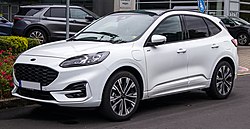South Africa
In South Africa, onwards from 2015, numerous Ford Kugas of the 1.6 L EcoBoost variant [20] [21] caught fire. [22] [23] [24] [25] In December 2016, Ford South Africa requested that all local Kuga owners take their vehicles in for a safety inspection. [26] As of 16 January 2017, at least 46 Kugas in South Africa had been destroyed by fire, [20] [27] [28] [29] and Ford South Africa had confirmed that a total of 39 incidents had been reported to the company. [21] By 18 January 2017, the number of incidents had reached 50, with 13 in 2017 alone. [30] Between November 2015 and December 2017, 72 vehicles suffered fires. [25] By 4 February 2019, more than 80 incidents had occurred, [31] with one as recently as 1 February 2019. [32]
On 16 January 2017, Ford South Africa and South Africa's National Consumer Commission [33] held a media briefing to announce a safety recall of the affected Kuga model, affecting "4556 1.6 L EcoBoost models that were built between December 2012 and February 2014". [20] [27] [34] The NCC said that it had decided to exercise its authority to authorize a recall on safety grounds, and had then been informed that Ford South Africa had decided to implement a recall. [21]
Between January 2017 and January 2018, Ford implemented three safety recalls on the vehicles. [25] Ford South Africa identified the mechanism leading to the majority of fires as overheating caused by a lack of coolant circulation, which could lead to cracking of the cylinder head, resulting in an oil leak and subsequent fire in the engine compartment. [20] [21] [27] The proposed solution would be first to replace and check affected components and systems, and later to improve the cooling and warning systems. [20] [34]
In December 2019, the National Consumer Commission fined the Ford Motor Company of Southern Africa R35 million in connection with the numerous fires, in addition to compensation payments already offered to affected parties. [35]
New Zealand
Television New Zealand reported that a Ford Kuga Titanium 2013 burst into flames in December 2016. The incident is being investigated by Ford NZ. Ford NZ say that the models being investigated in South Africa were built between 2012 and 2014 and fitted with a 1.6 L EcoBoost engine. They also say differences exist between the models sold in South Africa and those sold in New Zealand.
Until the investigation into the New Zealand incident has been completed, no decision can be made about recalling the 1,300 cars of the same model sold in New Zealand. [36]























